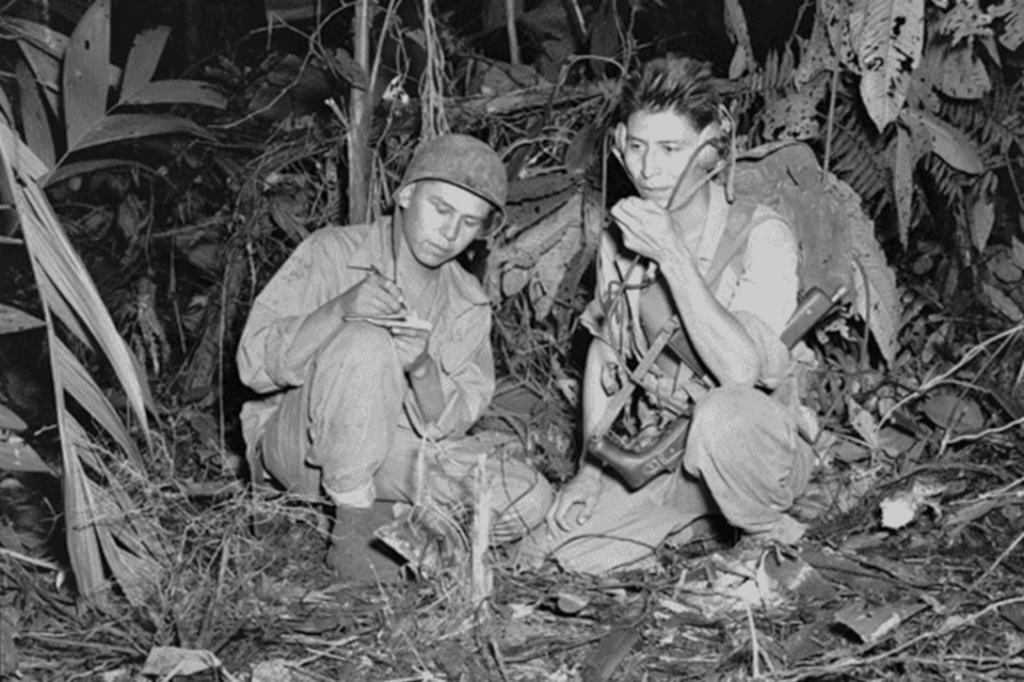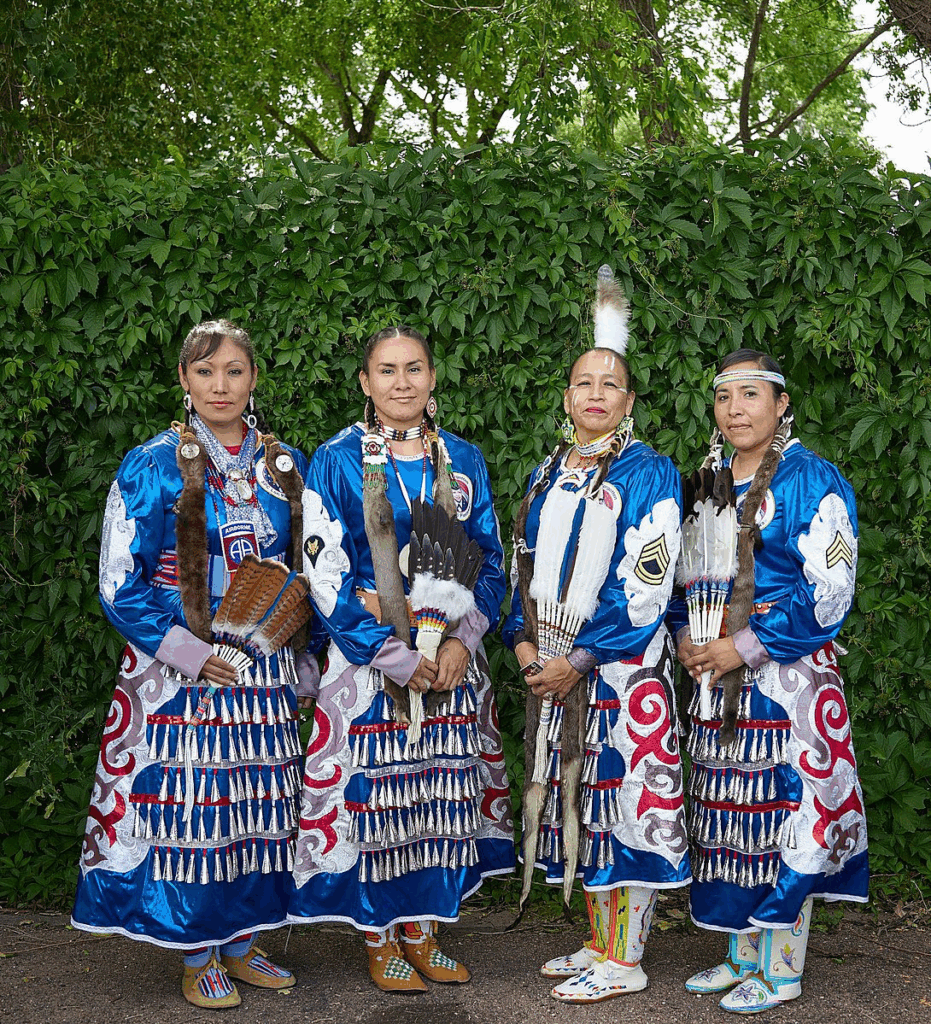Fall 2021
Native Americans have served extensively in nearly all wars fought by the United States, from the Civil War to the Iraq war. Today, Native People serve at a greater rate than any other demographic (Ault 2020). It is therefore important to recognize the vital contributions of Indigenous peoples to American war efforts, especially because these achievements are often overlooked. It is also crucial to understand the many, complex reasons why Native people choose to serve in the military. This blog highlights the experiences of Native people in the military, and ultimately recognizes Native service as heroic and vital acts of defense and resistance, whatever their reason for service.
WWI
More than 12,000 Indigenous people served in WWI, with countless more contributing to the domestic war effort. Some scholars estimate that almost a quarter of Native adults served in WWI (Ault 2020). To white Americans, the extensive Native service in the war was evidence that Native people had fully assimilated into American society, and embraced “traditional American values.” However, to many Natives serving in the war, their service was evidence of their readiness for the United States government to grant full citizenship to Native people. Furthermore, many of the Native Americans who served in WWI did not do so out of loyalty to the United States. Rather, their service was out of devotion to the land that they had always inhabited. Regardless, Native people often served on the front lines of the war, acting as scouts, snipers and runners (Calloway 2018).
WWII
About 25,000 Native Americans served for the United States during WWII, and many more worked for the war effort domestically. Five Native Americans won Congressional Honors for their effort in the war, and the Navajo code talkers, who used the Navajo language to send coded messages, were vital for the American war effort in the Pacific theater (Calloway 2018).
After the war, many Natives had made a reasonable income for the first time in their life. Many Native people chose to stay in cities and find work over returning to reservations, and many Native people used the GI bill to receive a college or vocational education. However, the Native people who served in the war and did return to the reservations were disappointed that there was no improvement in living standards and societal status. Indigenous people believed that their effort in the war earned them a better life in America, and were disappointed that domestically, attitudes towards Native Americans had hardly changed. In fact, many of the reservations were in bad shape economically after the war (Calloway 2018). While abroad, many Native servicemen remember little racism, as many served in white units and openly identified as Indigenous. In Malinda Maynor Lowery’s account of Native Americans from Robeson County serving in World War II, Lowery writes that Indigenous people shared living quarters and socialized freely with white people. Lowery also writes that Indigenous people were angry to return home to Jim Crow, where white people would turn them away from lunch counters or refuse to cut their hair. To Native veterans, Jim Crow seemed trivial (Lowery 2009).
Despite extensive Native service, Native lands and resources were appropriated by the US government for World War II. For example, more than 340,000 acres of land in the Pine Ridge Reservation in South Dakota were stolen by the US government for use as a shooting and bombing range. Some Japanese internment camps were located on Native land as well (Calloway 2018). Ultimately, World War II highlighted the hypocrisy of the United States. While the Native people were fighting for equality abroad, Indigenous people were still considered second class domestically.

Why Native People Serve
To non-Native individuals, it may be difficult to understand why Native people choose to serve in the military (Ault 2020). Why would Native people serve for a government that has taken land from, colonized and massacred them?
Many non-Native scholars believe that Native people serve because of “Warrior tradition,” or the idea that Native people are great warriors and it is honorable for them to protect their homeland. While this may be true for some individuals, this view vastly limits the scope of why Native people serve in the military (Ault 2020). In fact, many Native nations have pacifist traditions that greatly discourage violence and war. For Native Hawaiians, for example, service falls under their concept of Aloha, which is a word that describes the force that brings existence together, and includes mutual respect, cooperation and peace (Ault 2020).
Some Native people serve to honor their treaty promises, even though the United States has broken many of the treaties. One Indigenous Vietnam veteran says that although the United States hasn’t held up their treaty promises, “we are more honorable than that. [We] honor our commitments, always have and always will,” (Ault 2020, p.2).
Like anyone else, Native people serve this country out of love for their homeland, as a way out of poverty, because of familial ties to the military, or because they believe it is their duty to do so (Ault 2020). To many Native Americans, serving isn’t about protecting the United States society, it’s about protecting the land that they came from. D. J. Vanas, an Air Force captain and member of the Odawa nation says that “People ask, “Why serve in the military when this government has done so much to our people to hurt our culture?” But we’ve always looked at the bigger picture. This is our home, it always has been and always will be, and we sign up to defend that,” (Simkins and Barrett 2019).

In spite of the United States’ cruel and hateful colonial legacy, Native people have always served, and continue to serve for the United States military. Native people have looked past the hypocrisy of the United States and chosen to protect the land that they have always inhabited.
Whether that is fighting to prove that they deserve full citizenship in World War I, or fighting for human rights abroad in World War II and returning to racist attitudes domestically, many Native people have served this country with a benevolent and compassionate devotion. It is vital that we remember and recognize the many Native people who have served our country and we must support those that continue to do so.
Bibliography
Ault, Alicia. 2020. “The Remarkable and Complex Legacy of Native American Military Service.” Smithsonian Magazine, November 11, 2020. https://www.smithsonianmag.com/smithsonian-institution/remarkable-and-complex-legacy-native-american-military-service-180976264/.
Calloway, Colin G. 2018. First Peoples: A Documentary Survey of American Indian History. 6th ed. Boston: Bedford/St. Martin’s.
Lowery, Malinda Maynor. 2009. “Indians, Southerners, and Americans: Race, Tribe, and Nation during ‘Jim Crow.’” Native South 2 (1): 1–22.
Simkins, J. D., and C. Barrett. 2019. “A ‘Warrior Tradition’: Why Native Americans Continue Fighting for the Same Government That Tried to Wipe Them Out.” Military Times, November 15, 2019. https://www.militarytimes.com/off-duty/military-culture/2019/11/15/a-warrior-tradition-why-native-americans-continue-fighting-for-the-same-government-that-tried-to-wipe-them-out/.
